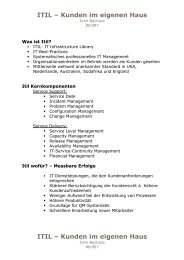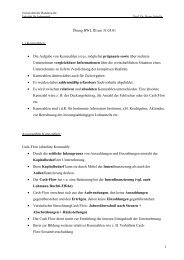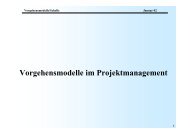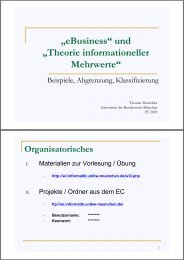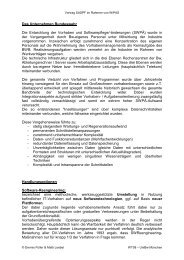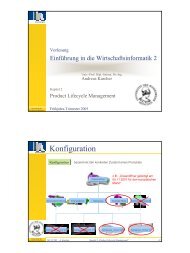Case Studies Voice over IP in Organizations - Informatik
Case Studies Voice over IP in Organizations - Informatik
Case Studies Voice over IP in Organizations - Informatik
You also want an ePaper? Increase the reach of your titles
YUMPU automatically turns print PDFs into web optimized ePapers that Google loves.
Universität der Bundeswehr München<br />
<strong>Case</strong> <strong>Studies</strong> <strong>Voice</strong> <strong>over</strong> <strong>IP</strong> <strong>in</strong> <strong>Organizations</strong><br />
<strong>Case</strong> <strong>Studies</strong> angefertigt von<br />
Achim Dannecker, Sean Eikenberg, T<strong>in</strong>o Gieslor, Leonhard Mertz, Ulrike Lechner<br />
Digitale Medien<br />
Prof. Dr. Ulrike Lechner<br />
Universität der Bundeswehr München<br />
Studiengang Wirtschafts<strong>in</strong>formatik<br />
der Fakultät INF und WOW<br />
Neubiberg
Die Daten für die Fallstudien wurden im Rahmen des Studienprojektes „Unterstützung<br />
von Geschäftsprozessen durch <strong>Voice</strong> <strong>over</strong> <strong>IP</strong>“ durch T<strong>in</strong>o Gieslor und Leonhard Mertz<br />
im Herbsttrimester / W<strong>in</strong>tertrimester 2005/2006 erhoben.<br />
Achim Dannecker, Sean Eikenberg und U. Lechner verfassten die Fallstudien.<br />
Wie bedanken uns bei allen Interviewpartnern und vor allem bei R. Rückert, Gonicus<br />
GmbH.<br />
II
1 <strong>Case</strong> Study: sd&m<br />
sd&m is an IT service provider and seated <strong>in</strong> Munich. The company offers IT<br />
development, <strong>in</strong>tegration, and consult<strong>in</strong>g services. It has a regional organization with<br />
branches <strong>in</strong> various cities <strong>in</strong> Germany. Furthermore, sd&m offers near shor<strong>in</strong>g through<br />
its near shore centre <strong>in</strong> Wroclaw, Poland. All services provided by sd&m are project-<br />
based. The project teams consist normally of sd&m and customer employees.<br />
Out of all case studies, sd&m is the only company which rejected Vo<strong>IP</strong> technology and<br />
re-<strong>in</strong>vested <strong>in</strong>to ISDN technology. When the company moved its headquarters <strong>in</strong> 2003<br />
with<strong>in</strong> Munich, it evaluated Vo<strong>IP</strong> technology for possible use. Accord<strong>in</strong>g to Mr. Schild,<br />
who is manag<strong>in</strong>g consultant of sd&m and responsible for the evaluation, sd&m based<br />
its rejection on the follow<strong>in</strong>g reasons: high costs for sufficient bandwidth and<br />
equipment, non exist<strong>in</strong>g advantages <strong>over</strong> ISDN technology, and miss<strong>in</strong>g benefits of its<br />
usage due to lack<strong>in</strong>g <strong>in</strong>ternal telephone traffic.<br />
Mr. Schild po<strong>in</strong>ts out that this decision was based upon broad knowledge of Vo<strong>IP</strong><br />
technology and its possible vendors:<br />
� In 2003 sd&m saw no real advantages of Vo<strong>IP</strong> <strong>over</strong> ISDN technology: sd&m<br />
employees usually work at sd&m or on the customer’s site, sd&m had and still<br />
has very good conditions with its mobile phone provider, the quality of video<br />
conferenc<strong>in</strong>g based upon ISDN was better than the Vo<strong>IP</strong> equivalent, ISDNbased<br />
call forward<strong>in</strong>g was sufficient for sd&m needs, the necessary<br />
prioritization process <strong>in</strong>volved with Vo<strong>IP</strong> usage was perceived as too complex<br />
and sd&m had no real need for CTI functionality.<br />
� The evaluation showed further that even though adm<strong>in</strong>istration costs would be<br />
roughly the same for both technologies (ISDN versus Vo<strong>IP</strong>) ‘<strong>in</strong>telligent’ Vo<strong>IP</strong><br />
equipment would be much more expensive than ‘normal’ ISDN phones. Both<br />
vendors, which were <strong>in</strong>volved <strong>in</strong> the evaluation process, offered the Vo<strong>IP</strong><br />
telephone system for a price which was double or quadruple the price of an<br />
ISDN based telephone system.<br />
� Although <strong>in</strong>ternal data security is not a big issue for sd&m, it is the op<strong>in</strong>ion of<br />
Mr. Schild that the higher complexity of a Vo<strong>IP</strong> based telephone solution would<br />
weaken its resistance aga<strong>in</strong>st hacker attacks.<br />
© 2006, A. Dannecker, S. Eikenberg, T. Gieslor, U. Lechner, L. Mertz<br />
1
Today, after hav<strong>in</strong>g successfully <strong>in</strong>stalled the new ISDN telephone system, sd&m is<br />
plann<strong>in</strong>g to re-evaluate Vo<strong>IP</strong> technology <strong>in</strong> 2007. Accord<strong>in</strong>g to Mr. Schild the reasons<br />
for this re-evaluation are the drop <strong>in</strong> cost for high bandwidth Vo<strong>IP</strong>, the higher<br />
configuration flexibility compared to ISDN technology and the aimed <strong>in</strong>tegration of<br />
sd&m with its parent company, Capgem<strong>in</strong>i, which has been us<strong>in</strong>g Vo<strong>IP</strong> technology for<br />
a while now.<br />
© 2006, A. Dannecker, S. Eikenberg, T. Gieslor, U. Lechner, L. Mertz<br />
2
2 <strong>Case</strong> Study German Automotive Manufacturer<br />
The headquarters of a German Automotive Company are seated <strong>in</strong> Munich. Its product<br />
range focuses on the premium segment of motorcycles, limous<strong>in</strong>es and sport utility<br />
vehicles. The company presents itself as sportive, high-tech and technology-savvy and it<br />
sponsors, e.g., formula 1 teams, golf events and yacht races. Accord<strong>in</strong>g to its website,<br />
the company has 5 design and research centres <strong>in</strong> three countries and 23 production<br />
facilities <strong>in</strong> seven countries. The company opened a new plant <strong>in</strong> Leipzig with modern<br />
telecommunications <strong>in</strong>frastructure <strong>in</strong> 2005. Agile production processes to produce any<br />
model on any production l<strong>in</strong>e with little switch<strong>in</strong>g costs are considered to be a<br />
competitive advantage of the company.<br />
The company has been switch<strong>in</strong>g to Vo<strong>IP</strong> s<strong>in</strong>ce 2005. The Vo<strong>IP</strong> system is a hybrid<br />
solution and the company utilizes a variety of Vo<strong>IP</strong> technologies. The previous<br />
telecommunications system was a conventional Siemens telecommunications system<br />
and GSM was used for field work.<br />
The reasons for evaluat<strong>in</strong>g and adopt<strong>in</strong>g Vo<strong>IP</strong> were:<br />
• the need to enhance the connections between the sites,<br />
• the need to improve knowledge management and, <strong>in</strong> particular, knowledge<br />
distribution with<strong>in</strong> the company,<br />
• the need to optimize the bus<strong>in</strong>ess processes, protect <strong>in</strong>vestments and provide<br />
value added services onsite. The <strong>in</strong>terview partner mentioned that bus<strong>in</strong>ess<br />
process optimizations have not been a ma<strong>in</strong> driver for the adoption <strong>in</strong> Vo<strong>IP</strong>.<br />
• cost reduction.<br />
The implementation of Vo<strong>IP</strong> <strong>in</strong> the company is an ongo<strong>in</strong>g and decentralized process.<br />
The company developed the <strong>in</strong>ternal knowledge about this technology for more than<br />
five years prior to implementation and conducted several <strong>in</strong>ternal pilot studies. The<br />
decision process <strong>in</strong>volved several work<strong>in</strong>g groups, committees and the board. The<br />
decision for Vo<strong>IP</strong> was done under the premise that the Vo<strong>IP</strong> solution could eventually<br />
be dismantled with<strong>in</strong> 2-3 weeks. The implementation of Vo<strong>IP</strong> took about one year at the<br />
plant <strong>in</strong> Leipzig and 1-2 years for other sites. The implementation was done by external<br />
service providers.<br />
© 2006, A. Dannecker, S. Eikenberg, T. Gieslor, U. Lechner, L. Mertz<br />
3
In Leipzig, bandwidth was not an issue, s<strong>in</strong>ce all workplaces had already 100MB<br />
connection and s<strong>in</strong>ce there were enough <strong>IP</strong> addresses available. Standardization and<br />
harmonization of Vo<strong>IP</strong> standards are an issue s<strong>in</strong>ce each site did an <strong>in</strong>dependent<br />
implementation and thus, technology differs between the sites.<br />
The implementation was organized as a project with its own buget. The project was on<br />
budget and on time. Major items <strong>in</strong> the budget were components for prioritization and<br />
the <strong>in</strong>frastructure (power and cool<strong>in</strong>g) for those components, costs of security checks,<br />
and additional servers for the updates of the new Vo<strong>IP</strong> telephones. Not <strong>in</strong>cluded <strong>in</strong> the<br />
budget were the costs the long transition phase is perceived to have caused and service<br />
<strong>in</strong>tegration. Overall, the implementation of Vo<strong>IP</strong> stayed with<strong>in</strong> the budget. Cost sav<strong>in</strong>gs<br />
were expected <strong>in</strong> particular for the site <strong>in</strong> Leipzig due to the Infrastructure already be<strong>in</strong>g<br />
<strong>in</strong> place.<br />
The functionalities of the Vo<strong>IP</strong> system <strong>in</strong>clude all the functions (answer<strong>in</strong>g mach<strong>in</strong>e,<br />
call queue) of the previous system. With <strong>in</strong>stant messag<strong>in</strong>g and collective call exist only<br />
<strong>in</strong> parts of the company and <strong>Voice</strong>mail is hardly used and will eventually be discarded<br />
<strong>in</strong> the future. The current implementation has access to the Outlook directory and the<br />
Outlook calendar.<br />
The <strong>in</strong>terview partner named several advantages of the Vo<strong>IP</strong> system compared to the<br />
previous ISDN system:<br />
� Vo<strong>IP</strong> was found to be effective for small project teams and <strong>in</strong> offices build<strong>in</strong>gs<br />
that are rented for a short time. Here, Vo<strong>IP</strong> was found to be more cost and time<br />
effective than conventional telephony<br />
� Easy-to-handle communication,<br />
� Improved knowledge diffusion,<br />
� Mobility of telephone numbers when employees move with their office<br />
� Vo<strong>IP</strong> <strong>in</strong>creased availability s<strong>in</strong>ce telephones reroute <strong>in</strong> case of failures and<br />
availability. Vo<strong>IP</strong>, VPN and GSM together ensure mobility of the workforce.<br />
However, functionalities such as book<strong>in</strong>g meet<strong>in</strong>g rooms or access to the cafeteria menu<br />
are perceived to be too expensive to be implemented. Note that ma<strong>in</strong>tenance and<br />
operations are done <strong>in</strong> an “out-task<strong>in</strong>g model” by service providers that have staff on-<br />
site.<br />
© 2006, A. Dannecker, S. Eikenberg, T. Gieslor, U. Lechner, L. Mertz<br />
4
The cost and sav<strong>in</strong>gs of this project<br />
� There are hardly any sav<strong>in</strong>gs with telecommunications costs s<strong>in</strong>ce the costs for<br />
calls with<strong>in</strong> Germany are already low and s<strong>in</strong>ce there were dedicated l<strong>in</strong>es to<br />
connect the sites of the company.<br />
� Cost sav<strong>in</strong>gs were expected for the site <strong>in</strong> Leipzig, s<strong>in</strong>ce telecommunications<br />
<strong>in</strong>frastructure with the necessary bandwidth was already <strong>in</strong> place.<br />
� A s<strong>in</strong>gle service centre can now take care of communications for the whole<br />
company.<br />
� The <strong>in</strong>formation desk has less work to do s<strong>in</strong>ce all telephone numbers are now<br />
up-to-date and available.<br />
The automotive manufacturer considers this to be a first implementation phase of Vo<strong>IP</strong><br />
and has plans to extend and enhance Vo<strong>IP</strong>. The focus of this first implementation phase<br />
was on <strong>in</strong>frastructure – not (yet) on value added services. All sites will move at least to<br />
a hybrid Vo<strong>IP</strong> system. The workplaces of tele-workers, which are equipped with ISDNtelephones<br />
are to be equipped with soft phones. Note that the telecommunications<br />
strategy changed with Vo<strong>IP</strong> from site strategies to a company wide strategy.<br />
The <strong>in</strong>terview partner mentioned that the hybrid, proprietary system is still very rigid<br />
and has limitations. It is frequently necessary to obta<strong>in</strong> licences and special licenses<br />
from the system provider. Lack of standards is an issue <strong>in</strong> this case s<strong>in</strong>ce all sites<br />
implemented Vo<strong>IP</strong> with <strong>in</strong>dividual service providers. Privacy and security are not a<br />
ma<strong>in</strong> concern with Vo<strong>IP</strong> technology s<strong>in</strong>ce the devices do all the encryption/decryption<br />
and dedicated l<strong>in</strong>es between the sites ensure security of the communication with<strong>in</strong> the<br />
company. Service contracts <strong>in</strong> the telecommunications sector used to be long term and a<br />
trend for shorter service contracts makes the handl<strong>in</strong>g of external providers and<br />
switch<strong>in</strong>g to a new technology less risky. The quality of Vo<strong>IP</strong> is very good and the<br />
employees adopted this technology reluctantly. The <strong>in</strong>terview partner recommends a<br />
step-by-step rollout compared to a big-bang implementation. Overall the project is<br />
considered to be a success with<strong>in</strong> the company.<br />
© 2006, A. Dannecker, S. Eikenberg, T. Gieslor, U. Lechner, L. Mertz<br />
5
3 <strong>Case</strong> Study Leibniz Comput<strong>in</strong>g Centre<br />
The Leibniz Comput<strong>in</strong>g Centre provides services to the scientific and academic<br />
communities <strong>in</strong> Bavaria and especially to Munich. The services c<strong>over</strong> general IT-<br />
services for the universities <strong>in</strong> Munich, communications <strong>in</strong>frastructure, a competence<br />
centre for data communication networks, archiv<strong>in</strong>g and backup of large amounts of data<br />
on extensive disk and automated magnetic tape storage, and a technical and scientific<br />
high performance Supercomput<strong>in</strong>g Centre for all German universities. 1<br />
Because of the fact that the Leibniz Comput<strong>in</strong>g Centre is a comput<strong>in</strong>g centre for all<br />
research facilities and universities of Bavaria it some of the questions that c<strong>over</strong><br />
bus<strong>in</strong>ess activities were not applicable. The <strong>in</strong>terview partner was part and responsible<br />
for the evaluation and implementation process of Vo<strong>IP</strong>. The implementation of Vo<strong>IP</strong><br />
was done by the Leibniz Comput<strong>in</strong>g Centre itself. The Leibniz Comput<strong>in</strong>g Centre had<br />
the necessary core competencies for this project and considered it a must to build<br />
knowledge and competence <strong>in</strong> that field.<br />
Before implement<strong>in</strong>g Vo<strong>IP</strong> the ma<strong>in</strong> arguments to evaluate Vo<strong>IP</strong> were that Vo<strong>IP</strong><br />
provides a better usage of the available network <strong>in</strong>frastructure and a relocation of the<br />
Leibniz Comput<strong>in</strong>g Centre to Garch<strong>in</strong>g. So the implementation of Vo<strong>IP</strong> at the old<br />
location was done provide experiences with this type of technologies by sett<strong>in</strong>g up<br />
extensive test scenarios. Another reason was to create an own knowledge base <strong>in</strong> the<br />
handl<strong>in</strong>g of Vo<strong>IP</strong>. As the Leibniz Comput<strong>in</strong>g Centre provides services and Vo<strong>IP</strong> might<br />
be a technology that is of <strong>in</strong>terest for their customers, it is a necessity to setup such a<br />
knowledge base.<br />
Before the implementation of Vo<strong>IP</strong> was done, the Leibniz Comput<strong>in</strong>g Centre used a<br />
traditional telephony solution based on ISDN technology. The Comput<strong>in</strong>g Centre L<br />
started to use Vo<strong>IP</strong> <strong>in</strong> 2000 by us<strong>in</strong>g a Cisco based solution. In 2004 the switched to an<br />
Asterix based solution. Each workplace <strong>in</strong> the new location is connected by 100MBit<br />
bandwidth that is more than sufficient to use Vo<strong>IP</strong>. The budget for Vo<strong>IP</strong> was part of the<br />
general IT budget. In the new location there are 265 Vo<strong>IP</strong> slots, while 100 slots are<br />
connected to fixed work places and the rest can be handled flexible.<br />
As hardware solution Cisco Gateways and Hard phones were implemented. As software<br />
solution Asterix and Soft switches were <strong>in</strong>stalled. The only problems while<br />
1 http://www.Comput<strong>in</strong>g Centre L-muenchen.de/wir/<strong>in</strong>tro/en/<br />
© 2006, A. Dannecker, S. Eikenberg, T. Gieslor, U. Lechner, L. Mertz<br />
6
implement<strong>in</strong>g Vo<strong>IP</strong> are based by some cod<strong>in</strong>g errors with<strong>in</strong> Asterix. All of them were<br />
fixed and not mission critical. Less effort is needed to adm<strong>in</strong>istrate the new system.<br />
Data protection and data <strong>in</strong>tegrity is from the perspective of Leibniz Comput<strong>in</strong>g Centre<br />
translated <strong>in</strong>to action. The complete network is switched and monitored. Telephone<br />
calls between the different locations are done by the traditional telephony networks.<br />
Tele workers use a complete encrypted network to connect. The tra<strong>in</strong><strong>in</strong>g of employees<br />
with<strong>in</strong> Leibniz Comput<strong>in</strong>g Centre is done by the Centre itself. There was no need to<br />
retra<strong>in</strong> anyone with<strong>in</strong> the Leibniz Comput<strong>in</strong>g Centre, even the ones that have to take<br />
care about the Vo<strong>IP</strong> system.<br />
Reflect<strong>in</strong>g the bus<strong>in</strong>ess processes there are just small improvements. The only value add<br />
of the Vo<strong>IP</strong> system reported by the <strong>in</strong>terview partners was that sett<strong>in</strong>g up and handle a<br />
telephone conference is easier is with the new Vo<strong>IP</strong> system. Additional services are not<br />
used. The employees would appreciate to have an automatic recall if a l<strong>in</strong>e is busy. That<br />
feature seems to be rather hard to implement. There was no need to change anyth<strong>in</strong>g <strong>in</strong><br />
the structure of the organisation and employees.<br />
Overall everyth<strong>in</strong>g went as expected. The employees do not have any problems with the<br />
new system and some of the features are really common (e.g. the new answer<strong>in</strong>g<br />
mach<strong>in</strong>e). At the beg<strong>in</strong>n<strong>in</strong>g the quality of speech was not that good but <strong>in</strong> the<br />
meanwhile everyth<strong>in</strong>g seems to be f<strong>in</strong>e.<br />
From the perspective of Leibniz Comput<strong>in</strong>g Centre it was a successful project which<br />
brought them forward from a technology po<strong>in</strong>t of view. Note that there are no plans for<br />
further <strong>in</strong>tegration or developments of new services.<br />
© 2006, A. Dannecker, S. Eikenberg, T. Gieslor, U. Lechner, L. Mertz<br />
7
4 Company I<br />
The Company I GmbH provides network-<strong>in</strong>frastructure and high reliability, high<br />
security solutions. In June 2004, Vo<strong>IP</strong> was implemented by an external service provider<br />
that was licensed by Cisco systems and two employees of Company I. In 2004,<br />
Company I moved to new offices and the leas<strong>in</strong>g contract of the Siemens telephony<br />
system was about to be f<strong>in</strong>ished and thus, Company I has been look<strong>in</strong>g for a new<br />
solution. The decision to move to Vo<strong>IP</strong> was more or less spontaneous and not ma<strong>in</strong>ly<br />
driven by rational evaluation criteria. The objectives for Vo<strong>IP</strong> implementation were<br />
• to build up new competencies with<strong>in</strong> Company I,<br />
• to advance Company I´s technological <strong>in</strong>frastructure and<br />
• to make the telephony system more <strong>in</strong>dependent.<br />
Note that Company I did not have a reeng<strong>in</strong>eer<strong>in</strong>g of the bus<strong>in</strong>ess processes <strong>in</strong> m<strong>in</strong>d.<br />
The implementation was a stand-alone project. The budget was approximately EUR<br />
30.000 and the project was on budget. The Vo<strong>IP</strong> <strong>in</strong>stallation <strong>in</strong>cludes 50 <strong>IP</strong> telephones<br />
of which 25 are WLAN telephones. The system is based on Cisco and IBM<br />
components. The soft phones on the Laptops were <strong>in</strong>stalled by Company I itself.<br />
Problems <strong>in</strong> implementation were the <strong>in</strong>tegration of the old, Fax-mach<strong>in</strong>e and several<br />
desired functions could not be implemented be external technicians. The Vo<strong>IP</strong><br />
telephones lack quick diall<strong>in</strong>g and the ergonomic design of the devices is perceived to<br />
be not very well done. Company I encounters sporadic system breakdowns of <strong>IP</strong>telephones<br />
due to faulty firmware and considers this dependency of (faulty) firmware to<br />
be a disadvantage of this technology. Initial problems with quality of speech were<br />
<strong>over</strong>come with updates.<br />
Ma<strong>in</strong>tenance of the telephone system was done by an external provider dur<strong>in</strong>g the first<br />
year and is done now by Company I itself. This <strong>in</strong>cludes system updates, hardware and<br />
user adm<strong>in</strong>istration. The <strong>over</strong>all cost is low. Comparison to the previous TK system is<br />
not possible s<strong>in</strong>ce adm<strong>in</strong>istration and ma<strong>in</strong>tenance have been done by a service provider<br />
for the old system. The ma<strong>in</strong> cost sav<strong>in</strong>gs occur because ma<strong>in</strong>tenance is done now<br />
<strong>in</strong>ternally and we do not have monthly costs any more (ma<strong>in</strong>tenance and leas<strong>in</strong>g). A<br />
hardware failure caused extra costs for Company I. Sav<strong>in</strong>gs <strong>in</strong> telephone costs have not<br />
been accounted for.<br />
© 2006, A. Dannecker, S. Eikenberg, T. Gieslor, U. Lechner, L. Mertz<br />
8
The advantages of the new system for the users <strong>in</strong>clude: more comfort, <strong>in</strong>tegration to<br />
exist<strong>in</strong>g systems is easier to implement and dial<strong>in</strong>g from an application is very<br />
comfortable. Employees of Company I accepted the new technology reluctantly. The<br />
<strong>in</strong>tegration of services is not <strong>in</strong> the focus for Company I and the <strong>in</strong>tegration with<br />
Company I CRM system is under preparation. Company I does not offer home office to<br />
its employees but the <strong>in</strong>terview partner was aware of the advantages of Vo<strong>IP</strong> telephones<br />
for home office. Vo<strong>IP</strong> had no effect on bus<strong>in</strong>ess processes or the organization of<br />
Company I. It is considered to be an advantage to dispose of the knowledge of Vo<strong>IP</strong><br />
technology to be able to provide the knowledge to the customers.<br />
Privacy and security were hardly considered issues s<strong>in</strong>ce the network of Company I has<br />
been considered secure and s<strong>in</strong>ce network access is be<strong>in</strong>g monitored. The data<br />
protection officer of Company I had been <strong>in</strong>volved <strong>in</strong> evaluation and implementation of<br />
Vo<strong>IP</strong>. The <strong>in</strong>terview partner concluded that there are no clear advantages for Vo<strong>IP</strong> and<br />
there Company I does not observe a trend towards <strong>IP</strong> <strong>in</strong> its customer base,<br />
© 2006, A. Dannecker, S. Eikenberg, T. Gieslor, U. Lechner, L. Mertz<br />
9



